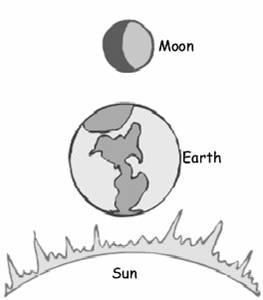From our perspective, the three objects that have the greatest impact on our lives are the Earth, Sun, and Moon. The Earth, of course, is the planet beneath our feet. Without it, well, we wouldn’t have anything at all. The Sun warms our planet, and with the Moon, creates the tides.
The Moon orbits the Earth and in turn, the Earth orbits the Sun. We see the Universe from a platform that is both rotating on its axis, and traveling in an elliptical orbit around the Sun. The Earth’s rotation on its axis makes the Sun rise in the east and set in the west, and is a big part of why the Moon rises and sets too; although the Moon takes 29 days to complete an orbit around the Earth as well.
The average distance from the Earth to the Moon is 384,403 km. And the average distance from the Earth to the Sun is 149,597,887 km. If you divide these two numbers, you get approximately 389. Now, if you divide the diameter of the Sun (1.4 million km) by the diameter of the Moon (3,474 km), you get 403. Those two numbers are pretty close. This is why the Moon and the Sun appear to be the same size in the sky; it’s a total coincidence.
Because they appear to be the same size in the sky, the Sun, Earth and Moon work together to create eclipses. When the Moon is directly in between the Earth and Sun, we see a solar eclipse. The Moon appears to pass in front of the Sun and darken it completely. And in the opposite situation, when the Earth is in between the Sun and the Moon, the Earth’s shadow darkens the Moon. This is a lunar eclipse. We don’t see eclipses every month because the Moon’s orbit it tilted slightly away from the Earth’s orbit around the Sun. Sometimes the Moon is above this orbit and sometimes it’s below, so it doesn’t block the light from the Sun, or get caught in the Earth’s shadow.
The Sun and the Moon work together to create the tides we experience here on Earth. Most of the rise of the tides comes from the gravitational pull of the Moon, but a small amount comes from the Sun. When the two objects are on the same side of the Earth, we get the highest and lowest tides, and when they’re on opposite sides of the Earth, the tides are less extreme.
The brightest object in the Sky is the Sun. Astronomers measure its apparent magnitude as -26.73. This makes it 449,000 times brighter than the full Moon. The brightness of the Moon is only -12.6. Of course all of the Moon’s brightness is just reflected light from the Sun.
We have written many articles about the Earth for Universe Today. Here’s a more detailed article about the Sun and the Moon.
Want more resources on the Earth? Here’s a link to NASA’s Human Spaceflight page, and here’s NASA’s Visible Earth.
We have also recorded an episode of Astronomy Cast about Earth, as part of our tour through the Solar System – Episode 51: Earth.
Reference:
NASA Earth Observatory

